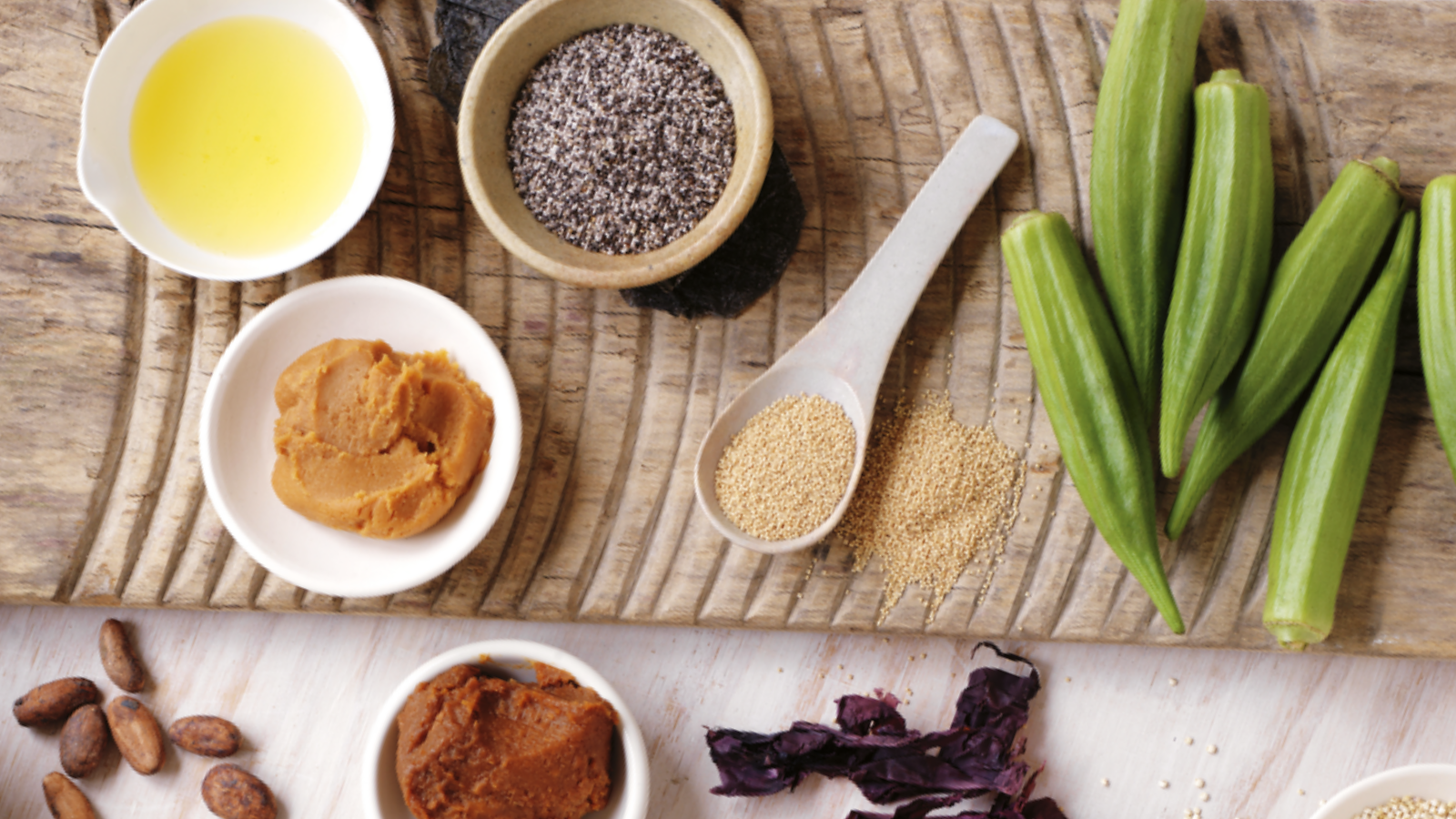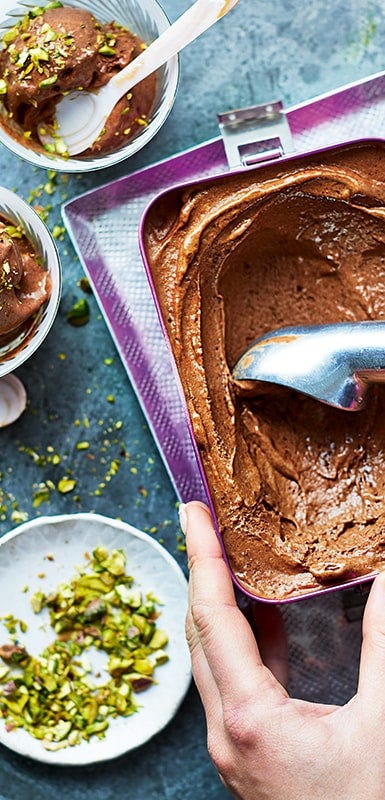9 superfoods you should be eating


Health benefits of superfoods
1. Okra
Readily available all year round, okra is a pod-shaped green vegetable that’s high in vitamin C, folate and magnesium, and a good source of fibre. “It tastes a little bit like zucchini,” says nutritionist and celebrity chef Janella Purcell. “It also thickens when you cook it, so it’s great to add to stews, soups, and casseroles.”
How to eat okra:
- Make a gumbo-style vegetable casserole.
- Stir-fry okra like you would broccoli or bok choy.
- Cut it in half, stuff it with cooked grains and grill.
2. Chia seeds
A natural source of plant-based omega-3 fatty acids, chia seeds are also rich in protein and soluble fibre. “Fibre helps slow down digestion and will make you feel fuller for longer. It also helps to moderate blood sugar levels, which can be beneficial for people living with diabetes,” says dietitian Nicole Stride.
How to eat chia seeds:
- Mix chia seeds through your breakfast muesli or yoghurt.
- Add to bread mixes or muffins.
- Blend into a smoothie or fresh vegetable juice.
3. Quinoa
Although it looks like a grain, quinoa (pronounced keen-wah) is a highly nutritious seed that, when cooked, has a similar consistency to rice or couscous. Quinoa is a good source of protein and has a low glycaemic index (GI), making it suitable for weight loss and people with diabetes. And it’s gluten-free, which is great for people with coeliac disease. Cook it as you would rice: one cup of quinoa to two cups of water. Rinse the seeds under cold water before cooking to remove their naturally bitter coating.
How to eat quinoa:
- Use it as a low-GI rice substitute when making homemade sushi.
- Mix with fresh herbs and add to grilled vegetables or salads.
- Cook in chicken stock as a side to barbecued lamb or fish.
- Make quinoa porridge, adding fresh fruit and yoghurt.
4. Seaweed
Eating these versatile sea vegetables offers numerous health benefits. “Seaweed is a great source of iodine, which is an essential mineral important for maintaining a healthy metabolism and healthy thyroid function, says Stride. Common types of seaweed include nori, wakame, dulse and arame, and they’re available from health food stores and Asian supermarkets. Seaweed can be eaten raw, roasted or rehydrated in water and then added to cooked dishes.
How to eat seaweed:
- Shred seaweed into soups or salads.
- Soak in water and use the liquid as a stock for cooking.
- Use it to make homemade sushi.
5. Tahini
Tahini is a nutty Middle Eastern paste made from the kernel of crushed sesame seeds. “Unhulled tahini is made with the sesame seed shell on it and, as a result is about four times higher in calcium than hulled sesame seeds,” says Purcell. Although high in oil, tahini is a healthy source of polyunsaturated fat, which can help to reduce cholesterol levels when it’s used in place of saturated fat.
How to eat tahini:
- Blend with chickpeas, lemon, garlic, and olive oil to make hummus.
- Use it as a healthy sandwich spread.
- Make a cheesecake with tahini, white miso, and silken tofu.
6. Raw cacao
Not to be confused with the highly processed cocoa, raw cacao is chocolate in its purest form. Free from added sugar, not only is it good for your waistline, it can help your heart as well. “Raw cacao contains high amounts of polyphenol, an antioxidant that can reduce levels of bad cholesterol,” says accredited practising dietitian Suchitra Khurana. It’s also high in mood-boosting magnesium and sulfur for healthy hair and nails. It does have a bitter taste, so remember that a little goes a long way. It’s sold as a powder, paste or in bite-sized nibs from health food stores.
How to eat raw cacao:
- Add a spoonful of the powder to mix in with your breakfast smoothie.
- Mix raw cacao nibs with hot milk to make a healthy hot chocolate.
- Replace cocoa with raw cacao when baking.
7. Macadamia nut oil
They’re one of the hardest nuts to crack, but inside the humble macadamia lies a lot of natural goodness, particularly its oil. “It’s considered a ‘good oil’ because it’s high in healthy monounsaturated fatty acids that help protect against heart disease,” says accredited practising dietitian Sarah Dacres-Mannings. The mild, buttery taste makes it a great addition to salad dressings and stir-fries. “Macadamia nut oil has a beautiful flavour. It also has a high heat capacity that makes it a good cooking oil,” says Dacres-Mannings. Unrefrigerated, macadamia nut oil has a shelf life of one to two years. Find it in supermarkets, and health and specialty food stores.
How to eat macadamia nut oil:
- Use it as a dipping for sourdough.
- Substitute it for butter or margarine when cooking.
- Stir-fry or lightly pan-fry chicken or fish with it.
8. Miso
A popular part of the Japanese diet, miso is often labelled the vegan’s yoghurt, since it contains beneficial bacteria (probiotics) that may support immunity and aid digestion. “If you’ve had diarrhoea, food poisoning or have been taking antibiotics, [the probiotics in] miso can help balance gut flora,” says Purcell. Made from fermented soybeans or grains such as brown rice and barley, miso can be bought as a thick, fresh paste or in instant powder form. Miso is low in fat and high in energy-boosting B vitamins. However, it’s also high in sodium, so it’s best to limit your intake of it if you’re following a low-salt diet.
How to eat miso:
- Mix a teaspoon of miso powder with a cup of hot water to make instant miso soup.
- Use miso like a stock cube. “Dilute it in water, so it forms a kind of paste, then add it to a stir-fry instead of chicken stock,” recommends Purcell.
- Include it in marinades and dressings for a flavour kick.
9. Amaranth
Similar to millet, buckwheat and bulgar, amaranth is a nutrient-dense wholegrain. “It has a high protein and fibre content and is a rich source of plant sterols, which have cholesterol-lowering properties,” says Stirling. Cook it the same way as rice or quinoa. “Try it as an alternative to rice or potato,” suggests Dacres-Mannings. It’s also gluten-free, which suits anyone intolerant to wheat.
How to eat amaranth:
- Sprinkle it raw onto breakfast cereal.
- Mix it with rolled oats, nuts, and seeds.
- Toast and enjoy as a snack.
- Cook and serve as a side dish.





















